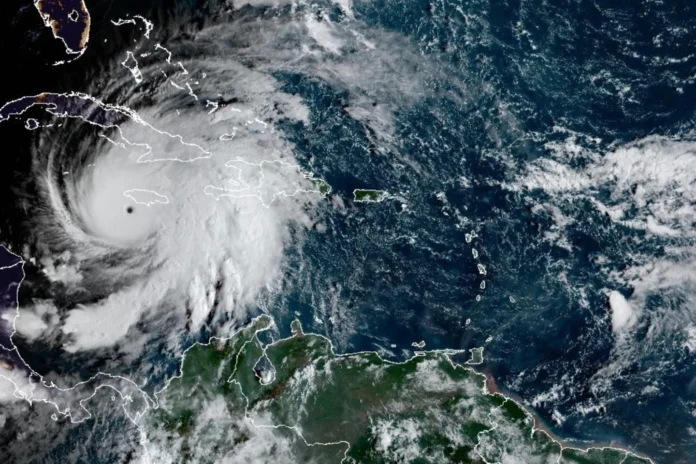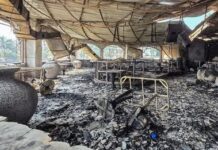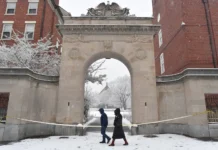(Reuters) – Hurricane Melissa unleashed devastation in Jamaica as the strongest storm on record ever to hit the Caribbean island nation, and roared later on Wednesday into eastern Cuba, smashing the city of Santiago and flooding rural land.
A Category 5 storm with sustained winds of 185 mph (298 kph) when it barrelled into Jamaica, Melissa had been downgraded to a still dangerous Category 3 when ithit Cuba with sustained winds of 120 mph, the U.S. National Hurricane Center (NHC) said.
“Life-threatening storm surge, flash flooding and landslides, and damaging hurricane winds are ongoing this morning,” the center said.
The historic storm blasted western Jamaica, demolishing homes, knocking down swaths of trees and washing out roadways. Authorities did not yet release details of fatalities but said they expected loss of life.
Eyewitness reports and videos on social media from Jamaica showed vehicles destroyed by flying debris, hotel doors blown off hinges and roofs scattered across neighborhoods. Video of the airport in Montego Bay showed inundated seating areas, broken glass and collapsed ceilings.
The storm was expected to weaken some as it crossed Cuba but would remain a dangerous hurricane upon reaching the Bahamas.
In eastern Cuba, around 735,000 people were evacuated from homes as the storm approached, authorities said. By mid-morning, President Miguel Diaz-Canel said Cuba had already suffered extensive damage and warned residents against letting down their guard, urging them to remain sheltered.
‘SOME LOSS OF LIFE EXPECTED,’ JAMAICAN LEADER SAYS
In southwestern Jamaica, the parish of St. Elizabeth was left “underwater,” an official said, with more than 500,000 residents without power.
“The reports that we have had so far would include damage to hospitals, significant damage to residential property, housing and commercial property as well, and damage to our road infrastructure,” Jamaican Prime Minister Andrew Holness said on CNN after the storm had passed.
The government had not yet received news of any confirmed deaths from the storm, but given the strength of the hurricane and the extent of the damage, “we are expecting that there would be some loss of life,” Holness said.
“It was so crazy. Like a freight train trying to come to a stop for eight hours,” said Journie Ealey, 34, a U.S. tourist on vacation in Jamaica, reached by phone. “I’ve never experienced anything like this before.”
Meteorologists at AccuWeather said Melissa ranked as the third most intense hurricane observed in the Caribbean, after Wilma in 2005 and Gilbert in 1988 – the last major storm to make landfall in Jamaica.
Scientists say hurricanes are intensifying faster with greater frequency as a result of warming ocean waters caused by greenhouse gas emissions. Many Caribbean leaders have called on wealthy, heavy-polluting nations to provide reparations in the form of aid or debt relief to tropical island countries.
Melissa’s winds subsided as the storm drifted past the mountains of Jamaica, lashing highland communities vulnerable to landslides and flooding.
“Our country has been ravaged by Hurricane Melissa but we will rebuild and we will do so even better than before,” Prime Minister Holness said early on Wednesday.
U.S. President Donald Trump said Wednesday he was prepared to assist Jamaica’s recovery. The State Department said it would send search-and-rescue teams.
In the Bahamas, next in line after Cuba in Melissa’s path to the northeast, the government ordered evacuations of residents in southern portions of that archipelago.
Farther to the east, the island shared by Haiti and the Dominican Republic had faced days of torrential downpours leading to at least four deaths, authorities there said.
CUBA HIT
The storm’s center, churning with violent wind gusts over 125 mph and heavy rain, slammed early on Wednesday into Guama, a rural, mountainous area 25 miles west of Santiago de Cuba, the island’s second most populous city.
The storm pressed on north-northeast across eastern Cuba. Authorities had shut down power to virtually all of eastern Cuba, evacuated vulnerable areas and had asked residents to shelter in place in the provincial capital Santiago, a city of 400,000 people.
Photos and videos posted early on Wednesday on local media and eyewitness accounts in the city laid bare a chaotic scene, with downed power lines, shattered windows, trees and debris littering roadways.
In more rural areas to the west, videos showed torrents of brown rainwater rushing down roads through dark towns at the base of Cuba’s Sierra Maestra mountains. As the storm passed, winds remained too strong by mid-morning for residents to venture onto the streets.
Authorities reported widespread flooding of lowland areas early on Wednesday from Santiago to Guantanamo, where upwards of 35% of the population had been evacuated.
The timing could hardly be worse for the communist-run Caribbean island, already suffering from food, fuel, electricity and medicine shortages that have complicated life, prompting record-breaking emigration since 2021.
President Diaz-Canel said Cuba had mobilized 2,500 electric line workers who would begin recovery immediately following the storm’s passage across the island later on Wednesday.
The hurricane was not expected to directly affect the capital Havana.



















